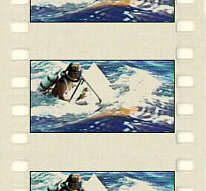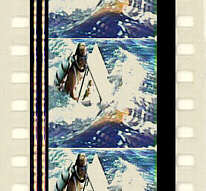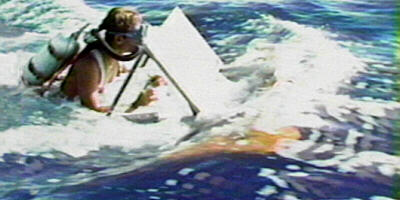
The Rich Man's
Poor Man's Version of CinemaScope
Superscope was conceived and developed by Irving and Joseph Tushinsky. Their process was created in the laboratory rather than the camera. It was their contention that Superscope anamorphic prints could be generated from straight 35mm negatives, or from double frame (VistaVision) or other wide area negatives. As far as is known, no producers of large format pictures took the brothers up on their offer but their concept was valid and variations of it would appear as special venue prints made by Technicolor for Paramount's VistaVision process and 35mm reduction prints from 65mm materials.
Photography in the Superscope process was generally no different than normal non-widescreen films. The only difference was that the entire silent 35mm aperture was utilized. Normal spherical lenses, much faster and lighter than the CinemaScope optics, were used. Since the process involved cropping of the camera negative to create the final print, shorter lenses with their inherently greater depth of field simplified production and didn't require the high light levels generally used for quality CinemaScope work.
The illustration is from the opening scene of RKO's first Superscope production, Underwater!, (1955).
The real work then began in the Technicolor labs. Technicolor produced silver separation matrices extracted from the camera negative using a 2:1 aspect ratio. RKO claimed to have canvassed theatres around the country studying the architectural environment and determined that the 2:1 ratio, quite a bit narrower than CinemaScope's 2.55:1, was the best option. In fact, the best option was to stay at 1.37:1 but RKO and the Superscope folks were telling the story, not yours truly.
Seen here is the composition area used for the extraction. In making printing matrices, Technicolor utilized the Tushinsky's Superscope printer lenses to impart a 2:1 anamorphic squeeze to the image. The squeeze was identical to CinemaScope's so that any theatre equipped for that process could show Superscope with a minimum of fuss.
Well, a minimum of fuss was the idea anyhow. No expensive stereophonic sound, no special camera lenses, standard cameras, it was just chock full of good economical ideas. And a few minor bonehead mistakes.
2x squeeze anamorphic print with standard optical sound. Since the screen ratio was 2:1 the image on the print was .715" x .715". The direct extraction from the centered silent aperture frame placed the Superscope frame in the center of the 35mm print. A black band was printed onto the right side of the image since the full available width, used by CinemaScope, was not utilized.
The big goof turned out to be the 2:1 image printed in the center of the film. Since the advent of sound on film, the image was offset by the area taken up by the soundtrack. Every theatre in the world had its projectors aligned for that offset. Even CinemaScope maintained the same centerline as the standard academy frame. But exhibitors had two choices with RKO Superscope, either show the picture off center on their screen or readjust their projectors, a difficult choice since trailers, newsreels, and all other films on the program adhered to the conventional image centerline.
Film as projected through a Superscope, CinemaScope, Panavision, or other standard 2:1 anamorphic projection optic. 
Click the Superscope Logo to see R.K.O.'s demonstration card illustrating how the process works
You are on Page 2 of
E-mail the author
CLICK HERE©1996 - 2004 The American WideScreen Museum
http://www.widescreenmuseum.com
Martin Hart, Curator